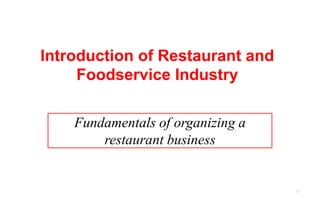
1 lecture.pptx
- 1. Introduction of Restaurant and Foodservice Industry 1 Fundamentals of organizing a restaurant business
- 2. History of the restaurant • The word "restaurant" comes from the Latin word restaur, which means restoration, strengthening. • The word was first used in 1765 by French culinary expert Boulanger in French restaurants. • Boulanger himself called the soup a restorative food, and he said, "Everyone who suffers from a stomach will come to me and restore it." Since then, the words "restoration" and "restaurants" have become widely used.
- 3. Scope of the Hospitality and Tourism Industries 3
- 4. The Interrelated Nature of Hospitality, Travel, and Tourism. 4
- 5. Restaurant Management Career Ladder 5
- 6. Foodservice careers • For organizational purposes, jobs in the foodservice industry are divided into two categories: front-of-the-house and back-of-the- house. • Front-of-the-house employees serve guests directly. Front-of-the- house positions include managers, assistant managers, banquet managers, dining room managers, maître d’s, hosts/ hostesses, cashiers, bar staff, serving staff, and busers. • Back-of-the-house employees work outside the public space. Back- of-the-house positions include chefs, line cooks, pastry chefs, dishwashers, bookkeepers, storeroom clerks, purchasers, dietitians, and menu planners.
- 7. Exhibition kitchens allow customers to watch chefs prepare their meals.
- 8. • Entry-level jobs in the foodservice industry include host/hostess, buser, assistant cook, server, expediter, and dishwasher. • Higher-level jobs include planning menus, developing recipes, managing a foodservice operation, writing about food, developing marketing and advertising strategies, teaching others about food and nutrition, and supplying food to restaurants. A buser clears and cleans tables and sets up tables for the next customers.
- 17. Commercial Restaurant and Foodservice Segment 17 The commercial segment makes up almost 80 percent of the restaurant and foodservice industry. Types of foodservice within this segment include restaurants, catering and banquets, retail, stadium, and airline and cruise ships:
- 19. Types of foodservice 19 Catering and banquets: In the catering and banquet segment, the menu is chosen by the host of an event for a specified number of people. Caterers may have their own facility or may also be located in another business, such as a hotel or a convention center, and provide foodservice to that business’s customers. They may also do off-site catering, which involves preparing food at one location and delivering it to the guest’s location. Retail: Retail stores offer prepared meals that can be eaten in the store or taken home. These products can be found in supermarkets, convenience stores, and specialty shops selling limited items such as coffee, doughnuts, and candies. Vending is also included in retail. Vending machines are available to dispense various types of food, such as sodas, sandwiches, and candy.
- 20. Types of foodservice 20 Stadiums: The food offered at stadiums stretches from the peanuts in the stands to the fine dining in the luxury suites. Some stadiums have privately run foodservice operations. However, most use large-scale contractors to handle the business. Airlines and cruise ships: In 2007, over 12 million passengers worldwide took cruises. Anyone who has ever taken a cruise knows that food is available 24/7 on the ship. Options range from casual dining and buffets to elegant dinners to room service. Food selection varies as well, from steak to vegetarian to children’s meals and pizza. Cruise ships may serve up to several thousand meals at each seating.
- 21. Types of foodservice 21 Stadium foodservice ranges from peanuts and quick service to fine dining in luxury suites.
- 22. Noncommercial Foodservice Segment 22 Schools and universities provide on-campus food services to students and staff. Military bases and ships provide food services to military personnel. Food is also offered at clubs, such as an officer’s club. Health-care facilities such as hospitals and long-term care facilities (including nursing homes and independent living centers for seniors, known as assisted living) offer foodservice. Businesses and industries offer foodservice as a convenience to employers and benefit to employees in manufacturing or service industries. Examples include cafeterias, executive dining rooms, and vending machines. Clubs and member-based facilities—golf, city, alumni, athletic—also offer foodservice as a convenience to their members and sometimes as a way to help provide the organization with additional funds. Within the noncommercial segment, foodservice is typically handled in one of two ways. In contract feeding, contractors are businesses that operate foodser- vice for companies in the manufacturing or service industry. These contractors will manage and operate the employee dining facilities. Some manufacturing and service companies are self-operators, which means they hire their own staff to operate foodservices.
- 23. Facts • Every year the market of restaurant services in Kazakhstan grows by 15%. • Today there are about 25,000 companies operating in the catering system in the country. • In addition, statistics show that every third restaurant goes bankrupt in the first three years. • A citizen of the Republic of Kazakhstan spends $ 18 a year on restaurants.
- 24. The average cost spent on a restaurant (Euromonitor, 2009)
